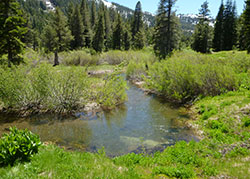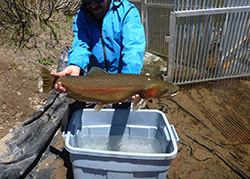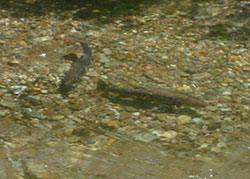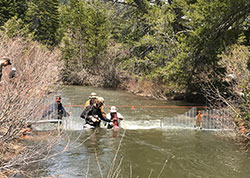
Upper Independence Creek provides vital spawning habitat for the Lahontan cutthroat trout in Independence Lake.

State and federal agencies, joined by conservation groups such as Trout Unlimited, have worked for decades to safeguard the wild Lahontan cutthroat trout population at Independence Lake, the only self-sustaining lake population of the native species left in California. Trout Unlimited’s Brandon Reeder shows off a hefty Lahontan cutthroat captured at a temporary weir to count spawning fish.

Lahontan cutthroat trout spawn in upper Independence Creek, where biologists have worked for years to remove non-native brook trout.

Each spring, biologists and volunteers set up a weir at upper Independence Creek to trap spawning Lahontan cutthroat trout and assess the population.
The news out of UC Davis last spring knocked California native fish biologists for a loop.
Genetic testing of native Lahontan cutthroat trout from Independence Lake in the Tahoe National Forest near Truckee found evidence of hybridization with non-native rainbow trout.
To understand the magnitude of that news you have to understand that Independence Lake is the only lake in California – and just one of two lakes in the world – to support a self-sustaining lake population of Lahontan cutthroat trout, a trout native to the eastern Sierra range and the Lahontan basin of Nevada.
And you have to understand that for decades, California Department of Fish and Wildlife (CDFW) biologists – joined by colleagues at the U.S. Geological Survey, U.S. Forest Service, the U.S. Fish and Wildlife Service and conservation groups including The Nature Conservancy and Trout Unlimited – have worked to safeguard these fish, enhance their habitat, and reduce competition from non-native brook trout, brown trout and Kokanee salmon introduced over the years into Independence Lake.
Lahontan cutthroat trout are listed as a threatened species under the federal Endangered Species Act. Their original listing in 1970 predates the modern act itself, which was passed in 1973.
Each fall, as part of species recovery efforts, biologists from CDFW and partner organizations electrofish upper Independence Creek, which feeds into Independence Lake, to remove brook trout from the creek that the Lahontan cutthroat trout depend on to spawn. Also in the fall, biologists set up a weir on the creek to block any of the lake’s resident brown and brook trout from moving up the creek to spawn. Non-native trout staging for a fall spawning run at the mouth of Independence Creek are stunned to the surface through electrofishing and removed from the lake.
“For the past 20 years at Independence Lake, we’ve been trying to give the cutthroat a helping hand by removing the non-native trout. It’s not a done deal but we’ve been pretty successful at reducing brown and brook trout down to very low numbers,” explained Dave Lentz, CDFW’s native trout conservation coordinator. “Lahontan cutthroat trout did not evolve with brook trout or brown trout on the landscape and they have been out-competed and displaced by these and other non-native species throughout much of the cutthroat’s historic range.”
Each spring, when the Lahontan cutthroat trout move up to spawn in upper Independence Creek, biologists and volunteers return with their weir to capture and count the numbers of spawning fish to assess population trends.
This spring, however, the spawning surveys will take on a new sense of urgency. After last year’s disheartening news from genetics experts, CDFW staff and partners captured some 170 Lahontan cutthroat trout from Independence Lake, took genetic samples and outfitted each trout with an identifying Passive Integrated Transponder (PIT) tag before releasing the fish back to the lake.
The tissue samples were sent to two labs for genetic testing. The results indicate that some 20 percent of the cutthroats captured and tagged last year show evidence of hybridization with rainbow trout. Biologists are now discussing plans and options for the spring spawn. Cutthroat trout returning to upper Independence Creek will be trapped and scanned with a PIT reader. Unmarked fish will be given a PIT tag, genetic samples will be taken for later testing, and the fish will be returned to the lake.
“We want to prevent further spawning by hybridized trout. We’re using some emerging science and the latest genetics information to manage this fishery,” said Lentz. “The situation is dire for Independence Lake cutthroat trout but we hope to improve their status by taking these measures.”
There are no known populations of rainbow trout within Independence Lake that could account for the hybridization but they are present in lower portions of Independence Creek below the lake. The outlet of the lake, however, is controlled by a dam that does not allow for fish passage into the lake. CDFW and partners will continue to investigate how rainbow trout gained access to the lake. It is thought that the rainbow invasion and hybridization are recent events, likely in the last 10 years.
The effort to remove hybridized cutthroat trout from Independence Lake takes place as state and federal officials in California, Nevada and Oregon step up collaborative efforts to increase Lahontan cutthroat trout awareness and recovery across their native range. Among those efforts:
- A genetic assessment of Lahontan cutthroat trout across their historic range has been underway for the past several years. That process resulted in the UC Davis findings of hybridization within the Independence Lake cutthroat population.
- In May 2019, the U.S. Fish and Wildlife Service released a document that updates recovery goals and objectives from its 1995 Lahontan cutthroat trout recovery plan using current science and a new conservation framework for species recovery.
- In October 2019, the U.S. Fish and Wildlife Service released 5,000 Pilot Peak strain Lahontan cutthroat trout back into Lake Tahoe, returning the native, fast-growing strain to Lake Tahoe for the first time in nearly 90 years.
- This coming May, state and federal fisheries biologists are scheduled to begin planning Lahontan cutthroat trout recovery and outreach efforts within the Carson River drainage.
- CDFW’s Hot Creek Trout Hatchery in the eastern Sierra is preparing facilities to establish a new rearing program for the Walker River strain of Lahontan cutthroat trout native to the Walker River drainage and Nevada’s Walker Lake.
CDFW Photo. Top Photo: A windy day at Independence Lake in the Tahoe National Forest.
Media Contact:
Peter Tira, CDFW Communications, (916) 215-3858